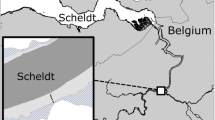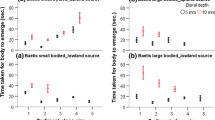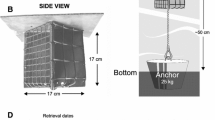Abstract
The vertical positioning of benthic invertebrates should be a trade-off between the risky, but productive, sediment surface and the safer, but physiologically harsher, conditions deeper down in the sediment. This is because the foraging efficiency of benthic fish decreases with sediment depth, whereas the sediment surface is generally better oxygenated and has a higher resource quality than lower layers. We studied how two benthic fish predators, bream (Abramis brama) and ruffe (Gymnocephalus cernuus), affected the community composition and vertical distribution of benthos, and their indirect effects on algae and suspended material, in field enclosures. Whereas bream had significant effects on the density, composition and distribution of the benthos, ruffe had no such effects. The total benthos biomass in bream treatments was an-order of magnitude lower in the upper sediment layer (0–1 cm) and three times lower in the middle layer (1–3 cm) than in the controls, whereas there were no significant effects in the deepest layer (3–10 cm). Bivalves persisted in the deepest layer although their density was reduced in shallow sediment, whereas gastropods faced the risk of local extinction in the presence of bream. As indirect effects, small-bodied cladocerans, phytoplankton, periphyton and both organic and inorganic suspended material were higher in the bream treatments. We␣conclude that the impact of bream diminished substantially with increasing sediment depth, enabling invertebrates to survive in the sediment and to persist in the presence of bream. However, there were␣no␣indications of any group adjusting their vertical position behaviourally as a response to predation threat.
Similar content being viewed by others
References
Appleton R.D. and Palmer A.R. (1988). Water-borne stimuli released by predatory crabs and damaged prey induce more predator-resistant shells in a marine gastropod. Proc. Nat. Acad. Sci. 85: 4387–4391
Abrams P.A. and Walters C.J. (1996). Invulnerable prey and the paradox of enrichment. Ecology 77:1125–1133
Beklioglu M. and Moss B. (1998). The effects of tench (Tinca tinca L.) and sticklebacks (Gasterosteus aculeatus L.) on planktonic and benthic communities in mesocosms in a shallow lake. Aquatic Ecol. 32: 229–240
Bergman E. (1990). Effects of roach Rutilus rutilus and two percids, Perca fluviatilis and Gymnocephalus cernuu: importance of species interactions for diet shifts. Oikos 57: 241–249
Bergman E. and Greenberg L.A. (1994). Competition between a planktivore, a benthivore, and a species with ontogenetic diet shifts. Ecology 75: 1233–1245
Blumenshine S.C., Lodge D.M. and Hodgson J.R. (2000). Gradients of fish predation alters body size distributions of lake benthos. Ecology 81: 374–386
Breukelaar A.W., Lammens E.H.R.R., Klein Breteler J.G.P. and Tátrai I. (1994). Effects of benthivorous bream (Abramis brama) and carp (Cyprinus carpio) on sediment resuspension and concentrations of nutrients and chlorophyll a. Freshwater Biol. 32: 113–121
Brooks J.L. and Dodson S.I. (1965). Predation, body size, and composition of plankton. Science 47: 364–372
Brönmark C. (1994). Effects of tench and perch on interactions in a freshwater, benthic food chain. Ecology 75: 1818–1828
Bund W.J. Van de and Groenendijk D. (1994). Seasonal dynamics and burrowing of littoral chironomid larvae in relation to competition and predation. Arch. Hydrobiol. 132: 213–225
Diehl S. (1992). Fish predation and benthic community structure: the role of omnivory and habitat complexity. Ecology 73: 1646–1661
Diehl S. (1995). Direct and indirect effects of omnivory in a littoral lake community. Ecology 76:1727–1740
Diehl S. and Eklöv P. (1995). Effects of piscivore-mediated habitat use on resources, diet, and growth of perch. Ecology 76: 1712–1726
Duncan R.S. and Szelistowski W.A. (1998). Influence of puffer predation on vertical distribution of mangrove littorinids in the Gulf of Nicoya, Costa Rica. Oecologia 117: 433–442
Fretwell S.D. (1987). Food chain theory: the central theory of ecology?. Oikos 50: 291–301
Fryxell J.M. and Lundberg P. (1998). Individual behavior and community dynamics. Chapman & Hall, London
Gawlik D.E. (2002). The effects of prey availability on the numerical response of wading birds. Ecol. Monogr. 72: 329–346
Gilinsky E. (1984). The role of fish predation and spatial heterogeneity in determining benthic community structure. Ecology 65: 455–468
Haddon M. Wear R.G. and Packer H.A. (1987). Depth and density of burial by the bivalve Paphies ventricosa as refuges from predation by the crab Ovalipes catharus. Mar. Biol. 94: 25–30
Hanson J.M. and Legget W.C. (1986). Effects of competition between two freshwater fishes on prey consumption and distribution. Can. J. Fish. Aquat. Sci. 43:1361–1372
Heinis F. and Crommentuiju T. (1992). Behavioural responses to changing oxygen concentrations of deposit feeding chironomid larvae (Diptera) of littoral and profundal habitats. Arch. Hydrobiol. 124: 173–185
Holt R.D. (1984). Spatial heterogeneity, indirect interactions and coexistence of prey species. Am. Nat. 124: 377–406
Hoogenboezem W., Boogart J.G.M. van den, Sibbing F.A., Lammens E.H.R.R., Teurlow A. and Osse J.W.M. (1991). A new model of particle retention and branchial sieve adjustment in filter-feeding bream (Abramis brama, Cyprinidae). Can. J. Fish. Aquat. Sci. 48: 7–18
Jansen V.A.A. (1995). Regulation of predator-prey systems through spatial interactions: a possible solution to the paradox of enrichment. Oikos 74: 384–390
Jespersen A.-M. and Christoffersen K. (1987). Measurements of chlorophyll a from phytoplankton using ethanol as extraction solvent. Arch. Hydrobiol. 109: 445–454
Kerfoot W.C. and Sih A. (1987). Predation: direct and indirect impacts in aquatic communities. University Press of New England, London
Kneib R.T. (1988). Testing for indirect effects of predation in an intertidal soft-bottom community. Ecology 69: 1795–1805
Kneib R.T. and Stiven A.E. (1982). Benthic invertebrate responses to size and density manipulations of the common mummichog, Fundulus heteroclitus, in an intertidal salt march. Ecology 63:1518–1532
Kornijów R. (1997). The impact of predation by perch on the size-structure of Chironomus larvae - the role of vertical distribution of the prey in the bottom sediments, and habitat complexity. Hydrobiol. 342/343:207–213
Lammens E.H.R.R. (1985). Resource partitioning and niche shifts of bream (Abramis brama) and eel (Anguilla anguilla) mediated by predation of smelt (Osmerus eperlanus) on Daphnia hyalina. Can. J. Fish. Aquat. Sci. 42:1342–1351
Lammens Geursen J. and McGillavry J. 1986. Diet shifts, feeding efficiency and coexistence of bream (Abramis brama), roach (Rutilus rutilus) and white bream (Blicca bjoerkna) in hypertrophic lakes. Proc. V Congr. Eur. Ichtyol. Stockholm. p. 153–162
Lee S.Y. (1996). Distribution pattern and interaction of two infaunal bivalves, Tapes philippinarum (Adams and Reeve) and Anomalocardia squamosa (Linnaeus) (Bivalvia: Veneridae). J. Exp. Mar. Biol. Ecol. 201: 253–273
Levin S.A. (1992). The problem of pattern and scale in ecology. Ecology 73: 1943–1967
Meijer M-L., de Haan M.W., Breukelaar A.W. and Buiteveld H. (1990). Is reduction of benthivorous fish an important cause of high transparency following biomanipulation in shallow lakes?. Hydrobiol. 200/201: 303–315
Palmer M.A., Covich A.P., Lake P.S., Biro P., Brooks J.J., Cole J., Dahm C., Gibert J., Goedkoop W., Martens K., Verhoeven J. and van de Bund W.J. (2000) Linkages between aquatic sediment biota and life above sediments as potential drivers of biodiversity and ecological processes. BioScience 50: 1062–1075
Persson A. (1997). Phosphorus release by fish in relation to external and internal load in a eutrophic lake. Limnol. Oceanogr. 42: 577–583
Persson A. and Hansson L.-A. (1999). Diet shift in fish following competitive release. Can. J. Fish. Aquat. Sci. 56: 70–78
Persson A. and Brönmark C. (2002). Foraging capacities and effects of competitive release on ontogenetic diet shift in bream (Abramis brama). Oikos 96: 271–281
Persson L., Diehl S., Johansson L., Andersson G. and Hamrin S.F. (1991). Shifts in fish communities along the productivity gradient of temperate lakes – patterns and importance of size-structured interactions. J. Fish Biol. 38: 281–293
Persson L. and Greenberg L. (1990). Optimal foraging and habitat shift in perch (Perca fluviatilis) in a resource gradient. Ecology 71:1699–1713
Ritchie M. (1998). Scale-dependent foraging and patch choice in fractal environments. Evol. Ecol. 12: 309–330
Rochette R. and Dill L.M. (2000). Mortality, behavior and the effects of predators on the intertidal distribution of littorinid gastropods. J. Exp. Mar. Biol. Ecol. 253: 165–191
Rundle S.D. and Brönmark C. (2001). Inter- and intraspecific trait compensation of defense mechanisms in freshwater snails. Proc. R. Soc. Lond. B. 268: 1563–1468
Savino J.P. and Stein R.A. (1982). Predator-prey interaction between largemouth bass and bluegills as influenced by simulated, submersed vegetation. Trans. Am. Fish. Soc. 111: 255–266
Scheffer M. and De Boer R.J. (1995). Implications of spatial heterogeneity for the paradox of enrichment. Ecology 76: 2270–2277
Schindler D.E., Hodgson J.R. and Kitchell J.F. (1997). Density-dependent changes in foraging specialization of largemouth bass. Oecologia 110: 592–600
Sommer U., Gliwicz Z.M., Lampert W. and Duncan A. (1986). The PEG-model of seasonal succession of planktonic events in freshwaters. Arch. Hydrobiol. 106: 433–471
Tátrai I., Lammens E.H., Breukelaar A.W. and Klein Breteler J.G.P. (1994). The impact of mature cyprinid fish on the composition and biomass of benthic macroinvertebrates. Arch. Hydrobiol. 131: 309–320
Thrush S.F. (1991). Spatial patterns in soft-bottom communities. TREE 6: 75–79
Thrush S.F. (1999). Complex role of predators in structuring soft-sediment macrobenthic communities: implications of changes in spatial scale for experimental studies. Austr. J. Ecol. 24: 344–354
Wellborn G.A., Skelly D.K. and Werner E.E. (1996). Mechanisms creating community structure across a freshwater habitat gradient. Ann. Rev. Ecol. Syst. 27: 337–363
Wilson W.H. (1991). Competition and predation in marine soft-sediment communities. Ann. Rev. Ecol. Syst. 21: 221–241
Winfield I.J. (1986). The influence of simulated aquatic macrophytes on the zooplankton consumption rate of juvenile roach, Rutilus rutilus, rudd, Scardinius erythophthalmus, and perch, Perca fluviatilis. J. Fish Biol. 29: 37–48
Yamada S.B., Navarrete S.A. and Needham C. (1998). Predation induced changes in behaviour and growth rate in three populations of the intertidal snail, Littorina sitkana (Philippi). J. Exp. Mar. Biol. Ecol. 220: 213–226
Zambrano L., Scheffer M. and Martinez R.M. (2001). Catastrophic response of lakes to benthivorous fish introduction. Oikos 94: 344–350
Acknowledgements
We thank Andreas Jezek and Marika Stenberg for␣help in the field and for analysing sediment samples, and Pia Hertonsson for analyzing the invertebrate samples. We are also grateful for the␣insightful comments provided by the Benthic-Pelagic Coupling Group on a previous draft. Financial support was provided from the Swedish Research Council for Environment, Agricultural Sciences and Spatial Planning to AP.
Author information
Authors and Affiliations
Corresponding author
Rights and permissions
About this article
Cite this article
Persson, A., Svensson, J.M. Vertical distribution of benthic community responses to fish predators, and effects on algae and suspended material. Aquat Ecol 40, 85–95 (2006). https://doi.org/10.1007/s10452-005-9014-2
Received:
Accepted:
Published:
Issue Date:
DOI: https://doi.org/10.1007/s10452-005-9014-2




